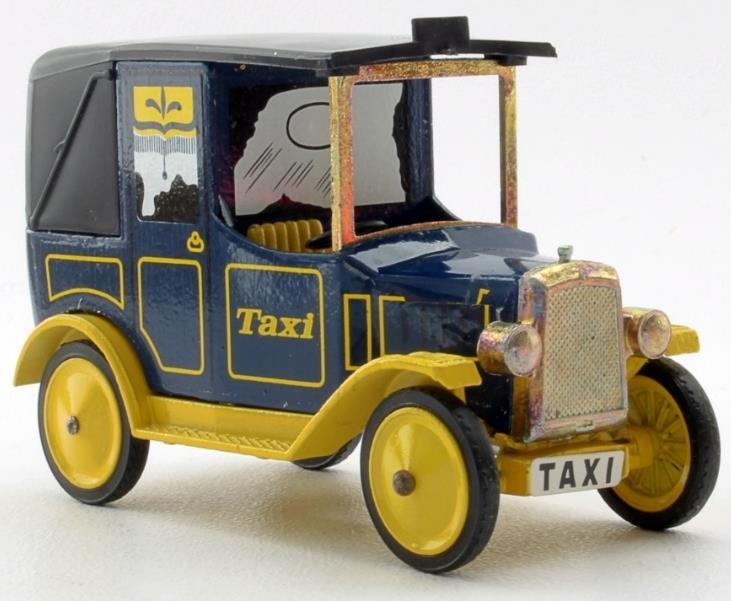Centuries of history and a rich culture
Femmes Cocher

Taxicab driver Inès Decourcelle rests against the steering wheel of an early automobile in this postcard from the Femmes Cocher collection gathered by taxi researcher Norman Beattie. The series celebrates the role of women drivers in the Paris taxi trade during the early 1900s. Beattie's authoritative discussion of the times and lives of the women adds meaningful narrative to an extraordinary collection of images. Together they open a window on the last days of the horse-drawn era and the dawn of the automobile age.
Gaito Gazdanov's Paris
Gaito Gazdanov was a Russian emigre who drove a taxi in Paris from 1928 to 1952. During that time, he wrote seven of his nine novels.
Gazdanov's novel Nochnye dorogi (Night Roads) draws heavily on his life as a taxi driver. Originally titled Nochnaia doroga (Night Road) it was serialized in the emigre journal Sovremennye zapiski in 1939-1940. It did not appear as a book until 1952.

Gaito Gazdenov in the 1930s
The novel was translated to French by Elena Balzanno (Chemins Nocturnes: Viviane Hamy, 1991). An English translation is now available.
Click here for photos and selections translated to English from French by Norman Beattie.

A Parisian taxicab of the 1930s

"Chemins Nocturne" and other works by Gaito Gazdanov are available in French from Editions Viviane Hamy. Justin Doherty's English translation of "Night Roads" was published by Northwestern University Press in 2009. See also Norman Beattie's web essay and photos on Gazdanov.
Many thanks to Justin Doherty of Trinity College, Dublin for his recent translation of Gazdanov's Night Roads from Russian to English. Gazdanov conveys his readers to 1930s Paris and introduces us to the city's late night characters. Night Roads is a great read, and is available from Northwestern University Press.
Taxicab Numbers
Srinivasa Ramanujan, a mathematician who is associated with Taxicab Numbers.
Taxicab Numbers are a mathematical function of cubes. The numbers are difficult to compute and only six have been discovered. The series increases so rapidly that only two Taxicab Numbers can possibly appear as the numbers on real world taxicabs. They are 2 and 1729.

Henry J. Kaiser presenting Kaiser-Frazer car to veteran owned and operated G.I. Taxi company, 1948. More at Kaiser on veteran employment and benefits..
Tipping
The Drivers of Social Preferences: Evidence from a Nationwide Tipping Field Experiment by Bharat Chandar, Uri Gneezy, John List and Ian Muir at the University of Chicago. This 2019 paper is a big-data analysis of tipping behavior in 40 million UberX rides. About 16% of rides were tipped. 60% of UberX riders never tip and just 1% of riders always tip. The authors had access to an enormous amount of data and conducted experiments within the Uber app such as varying the suggested tip amounts. They found many interesting patterns linked to time and location of trips, gender, age and ethnicty of drivers and riders, the frequency of rapid accelleration or hard braking, and more.
Kareem Haggag and Giovanni Paci authored a discussion paper for the Department of Economics at Columbia University titled Default Tips. The March 2013 study examined 13 million credit card transactions in New York City taxicabs. The authors determined that the default tips suggested to passengers on rear-seat terminals have a large impact on tip amounts. Generally tip amounts are higher, but the authors "highlight a potential cost of setting defaults too high, as a higher proportion of customers opt to leave no credit card tip when presented with the higher suggested amounts."
What sustains social norms and how do they evolve? The case of tipping, an article by economist Ofer H. Azar (258KB pdf). Originally published in the Journal of Economic Behavior and Organization, the paper presents a model of the evolution of social norms. From the abstract: "When a norm is costly to follow and people do not derive benefits from following it except for avoiding social disapproval, the norm erodes over time. Tip percentages, however, increased over the years, suggesting that people derive benefits from tipping, such as impressing others and improving their self-image as being generous and kind."
The History of Tipping - From Sixteenth-Century England to United States in the 1910s by Dr. Ofer Azar. From the abstract: "This article reviews the early history of tipping and offers an economic analysis of different aspects of tipping. Using the historical evidence, it then addresses two major questions about tipping: why do people tip? And does tipping improve service quality?"
Other works on tipping by Dr. Ofar Azar, an economist at Northwestern University and Ben-Gurion University.
The Itching Palm: A Study of the Habit of Tipping in America by William Rufus Scott is a 1916 attack on tipping as "a willingness to be servile for a consideration." Digitized book courtesy of Google. (2MB pdf)
To Insure Prejudice: Racial Disparities in Taxicab Tipping by Ian Ayres , Fredrick E. Vars and Nasser Zakariya of Yale Law School, Miller Shakman & Hamilton and Harvard University. From the abstract: "Many studies have documented seller discrimination against consumers, but this study tests and finds that consumers discriminate based on the seller's race."
Mega Tips - Scientifically Tested Techniques to Improve Your Tips by Dr. Michael Lynn, Associate Professor at the School of Hotel Administration, Cornell University. (586KB pdf)
Why Do We Tip Taxicab Drivers? by David Flath, North Carolina State University - Department of Economics, September 2004. From the abstract: " Tipping thus represents a frank acknowledgment that the posted fare or regulatory determined fare is non-binding; the tip is simply the portion of the agreed fare in excess of the regulated one."
Taxi Matchbooks and Matchbook Gallery
Taxi matchbook advertising has a long history, illustrated here with matchbook covers from (almost) all US states and Canadian provinces. The colorful gallery and accompanying commentary by Norman Beattie expolre both the uniqueness of the images and commonalities in marketing strategies.

Common graphic themes on taxi matchcovers
Taxis and San Francisco Labor History
Taxis and San Francisco Labor History tells the story of organized labor unions in the SF taxi industry for more than 100 years.

Drivers returning to work at the end of a strike, 1949
Virtual Museum of Taximeters has lots of photos of vintage taximeters from all over the world. Ricardo Gallo, the site owner, collects photos of taximeters and also collects the real thing with over 100 meters in his collection already.

Vintage meter from Uruguay courtesy of Virtual Museum of Taximeters
New Deep City Press

- Cover by Jamie Maddox, Spring 1977
The New Deep City Press presented the world as seen by San Francisco taxicab drivers in the 1970s. The publication nicely captured the spirit of the times in words, images and original art.
The New Deep City Press was a driver-produced publication in San Francisco. Its six issues featured industry news, photos, original art, tales of the road, poetry, social commentary and more. These four issues are posted by permission of Ralph Hoffschildt and Jesus Portillo. Scanning is courtesy of Alan Freberg and Don Anderson. The March 1976 issue is 31 pages, 6.9 MB. The Winter 1976 issue is 57 pages, 7.4 MB. The Spring 1977 issue is 59 pages, 12.8 MB. The 1978 issue number 11 is 64 pages, 24.0 MB. Scanning and archiving of the Deep City Press is an ongoing project, with the July 1976 issue preserved as individual page scans in two zipped packages: pages 1 through 25 and pages 26 through 48 which are 6.9 MB and 5.8 MB respectively. The covers of all six issues are combined here in one graphic. Ralph advises that readers are welcome to share or reprint issues for personal use but not for profit. For other uses contact Ralph Hoffschildt for permission.

Drivers and friends pose for the camera at City Cab in San Francisco, 1976.
From the New Deep City Press.
Taxis In Literature and Art
Ten Of the Best Taxis in Literature are the picks by John Mullan in the Guardian.

Who is going to Barker Street? Try the Five Taxis Puzzle!
The Five Taxis Puzzle named "Who is going to Barker Street" challenges five cab drivers to figure out where their five drunk passengers are going. Give it a try and enjoy! If you get stumped, Norm Beattie will show you the way.

Nobody's Angel by taxi driver Jack Clark
Nobody's Angel by taxi driver Jack Clark features a hard-boiled cabbie in Chicago who takes a personal interest in preventing crime.
Last Call At The Ringnose Pub by Montreal writer and taxi driver Peter Foster is a mystery story set in 2013 against a backdrop of the contraband cigarette trade.
Still Life in Moving Vehicles by Dale Konstanz includes a delightful collection of photos that focus on the superstitious and religious objects inside Bangkok taxis. Dale's book entitled 'Bangkok Taxi Talismans' will be published by River Books in 2010.

"Yellow Cab" by anthropology professor Robert Leonard, is a portrait of the city he found while moonlighting as a cab driver on the streets of nighttime Albuquerque, New Mexico.
The Owl Taxi by Hulbert Footner is a full-length book published in 1921. It is a detective story centered on cabs in Manhattan. Right click the image to download this 14.5 MB PDF file which is a photo-digitized version of the hard-cover book. Document courtesy of Norman Beattie.

Title page from the 1921 printing of The Owl Taxi by Hulbert Footner.
Vance Thompson (1863-1925) was an American author who wrote novels, short stories, nonfiction books and journalism. He traveled widely in Europe, and between 1903 and 1908 he published five articles in Outing magazine on horse cab drivers in Paris, London, Dublin and New York and on gondoliers in Venice. Taken together the five articles form a kind of cross-cultural survey of cab driving in the twilight of the horse-drawn era. Many thanks to Norman Beattie of Winnipeg for preparing this outstanding collection of text and photos, one of the best and most interesting historical works on Taxi-Library.
"Mystic Gypsy Mavericks, Dharmic Visions of a Vegas Cabbie" is the 2005 book by Las Vegas driver Tim Hollis. Read an extract from the book or contact CafePress to obtain hard copy and digital editions.

Live streaming video from New York City's Taxi Talk program 10:30 pm on Friday nights; click on MNN's Channel 67. Also on the web, live-streaming Taxi Talk radio from WWRL-1600 AM on Friday afternoons between 2:30 pm and 3:00 pm New York City time.
Notes, Quotes and Anecdotes: this delightful and often hilarious collection from researcher Norman Beattie is a goldmine for speakers
San Francisco Taxi: A 1st Week in the Zen Life... by Alex Sack in which he navigates through a 1st week in the life of a big city cabbie.


Murder Lost To Time: The True Story of One of Canada's Oldest Unsolved Murders
This June 2017 book recounts a relative's determined search for answers a century after the fact, and a taxi driver's dangerous association with criminals in Prohibition-era Canada. Available through Amazon.
UK and Europe

The different sections of the NTA logo represent the different nations that the association represents: top left is the English National Flower; top right is the Irish emblem of the shamrock; bottom left is the Scottish Thistle; and bottom right is the Welsh leek. The association's motto "ubique" means "everywhere."
The National Taxi Association represents taxi associations and individual taxi proprietors throughout England & Wales. Formerly known as the National Federation of Taxicab Associations, the NTA traces its roots back 50 years.
Brian Halpin sends a 2009 flyer inviting drivers to join the Taxi Branch of the Independent Workers' Union in Ireland. (45kb PDF)
Licensed Taxi Drivers' Association, London, UK.
A brief history of the London Taxi

June 16 is Bloomsday. Spend a few minutes getting up to speed on the theme of cabs and cab drivers in "Ulysses" by James Joyce. This is another delightful collection of images and text from Norm Beattie. He captures the spirit of June 16, 1904 when Joyce's character Leopold Bloom took his long walk through the city of Dublin in Ireland.
1860 Interview with a London Cabby, by Charles Dickens, contributed by Norman Beattie
History of the London Taxi and Victorian Horse Cabs, high quality booklets by Shire Publications in the UK.
Shire Publications, source of books on history of the London Cab and Victorian and Edwardian Horse Cabs. [Click on "Motoring" and "Forthcoming Titles"]
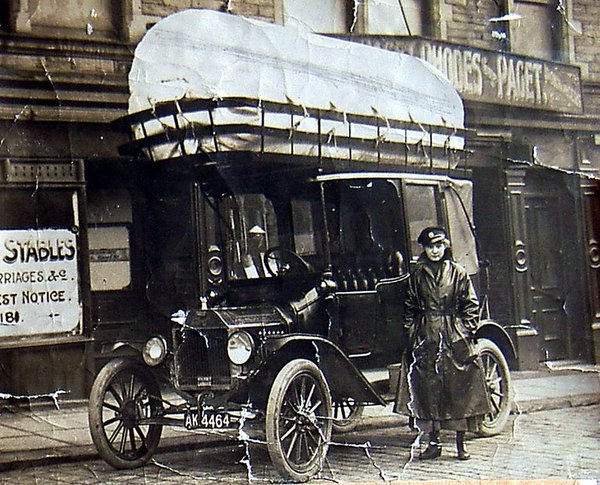
A 1920s coal-gas powered taxicab operated by John Lee Automobile Engineers in Keighley, England. The bag atop the vehicle stored sufficient fuel for 15 miles of driving. Fast forward to 2007...according to an article in The Conservative Voice, more than 1000 taxicabs in the Chinese city of Fuxin have switched from gasoline to compressed coal-based methane (CBM) fuel.
London taxi history, part of Jamie Owens' London taxi page
Nash's Numbers, London driver Alan Nash has crunched the numbers for just about everything. Highly recommended for drivers who are compiling listings of night spots, theaters, etc.
 -Photo supplied by FreeFoto.com
-Photo supplied by FreeFoto.com
The colorful London "black cabs" of today
Bill Clark's Taxi Blog comments on the UK taxi business
NetXposure, high quality historical taxi photo calendars from London driver Vince Chin
Belfast Taxi: A cast of colourful characters feature in Lee Henry's 'brilliantly researched root and branch history of taxiing in Belfast'. Published 2012 by Blackstaff Press.
Institute for Transport Studies, University of Leeds, UK
Jeremiah Ryan's Taxi Ireland, what's happening with Ireland's taxi industry, including news, Dublin rates of fare and permit prices.
 - From a postcard, date unknown
- From a postcard, date unknown
A Paris horse cab driver enjoying a glass of his favorite beverage. Note the early taximeter.
Vance Thompson (1863-1925) was an American author who wrote novels, short stories, nonfiction books and journalism. He traveled widely in Europe, and between 1903 and 1908 he published five articles in Outing magazine on horse cab drivers in Paris, London, Dublin and New York and on gondoliers in Venice. Taken together the five articles form a kind of cross-cultural survey of cab driving in the twilight of the horsedrawn era. Many thanks to Norman Beattie of Winnipeg for preparing this outstanding collection of text and photos, one of the best and most interesting historical works on Taxi-L.
 A male passenger makes a ribald suggestion to the lady horse cab driver.
A male passenger makes a ribald suggestion to the lady horse cab driver.Postcard from the Femmes Cocher collection gathered by Norman Beattie.
The delightful Femmes Cocher collection of postcards from the early 1900s celebrates the role of women in the Paris horse cab trade. Many thanks to Winnipeg librarian (and former taxicab driver) Norman Beattie for this visual treat combined with sound historical research.
Many thanks to the Union des Taxis Ruraux for links to French-language taxi sites Forum de discussion des taxis francophones, and Annuaire des taxis francophones.
Paris taxis during WWI transported troops to the front. See also an 18-second video clip of this historic moment relating to the First Battle of the Marne.
Portal del Taxi Europeo, personal page of M. Tomas, president of the Confederación Europea del Taxi
Taxi de Barcelona, directed to the taxi driving community in Barcelona, Spain
Hansom Cabs on London Streets are seen throughout this 1903 video. Don Anderson suggests: "Fans of traffic history should like this video of Old London Street Scenes -- the hansom cabs are the ones with the drivers perched on the back, holding the reins over the top. Those are real cabriolets, not like those automobiles you call cabs! Cab-related scenes include cabbies watching the sides of the street for possible fares, and another cabman opens the lid on the top of the cab to talk to his passenger inside."
 A hansom cab on location for the TV movie "Sherlock Holmes and the Case of the Silk Stocking" at Somerset House in London. Photo courtesy of Wikipedia.
A hansom cab on location for the TV movie "Sherlock Holmes and the Case of the Silk Stocking" at Somerset House in London. Photo courtesy of Wikipedia.
Taxi-in-Berlin, German language page with news and links to cab services
Funk Taxi Berlin, website of the Berliner Cab Owners Association, includes versions in German and English
HalloTaxi, Hungarian language online taxi magazine

Classic Volvo Duett taxicab

Punch magazine illustration from October 11, 1879
Canada
 One of the 1920s Diamond Cab Staff photos gathered by Norm Beattie
One of the 1920s Diamond Cab Staff photos gathered by Norm Beattie Norm Beattie offers a graphic history of the taxi industry in Winnipeg. This is one of the best image collections on Taxi-Library and is highly recommended!
Ms. Cab Driver, a Woman Cab Driver in Winnipeg, contributed by Norman Beattie

Histoire du taxi à Montréal, Des taxis jaunes à UberX by Jean-Philippe Warren is a 2020 book by a professor of sociology and anthropology. See a English language review of the book on the website of Concordia University.
Continuity and Discontinuity in Canadian Cab History, by Donald. F. Davis, October 1998
The Ballad Of George Alfred Beckett, text and recording about the murder of taxi driver Nick Marthos in 1930.

Taxi driver's badge from Blind River, Ontario. Photo courtesy of Norman Beattie.
Taxi and chauffeur badges are displayed in an historical collection of North American taxi and chauffeur badges...hundreds of photos, highly recommended.
Montréal Taxi Blog by Jean Schoeters includes a nice collection of historical images.

The mysterious death of Ottawa hackman Alfred Bonenfant in 1908 turned out to be accidental. Yet the story of the incident and the inquest that followed shine a light on the horse taxi trade just prior to its eclipse by automobiles. This is another excellent collection of text and photos by Canadian taxi historian Norman Beattie.
The Independent Servant: A Socio-Cultural Examination of the Post-War Toronto Taxi Cab Driver, 2006 doctoral dissertation by Kimberly M. Berry.

Taxi history from the 1870s to 1960s is illustrated with more than 100 photos. Text by Norman Beattie chronicles the transition from small horse-drawn liveries operating out of stables to fleets of Cadillacs, Nashs, Packards and Studebakers. Winnipeg Cab History is an enthralling read for taxi folk everywhere.
Taxi! is an hour-long documentary about Toronto taxicab drivers in the days before GPS and computerized dispatching. The 1982 film is by Barry Greenwald and is hosted on the web site of the National Film Board of Canada.

- Austin FX3 vintage London taxi now in Canada. Photo by Norm Beattie, 1994. Below, the exact same vehicle in London.
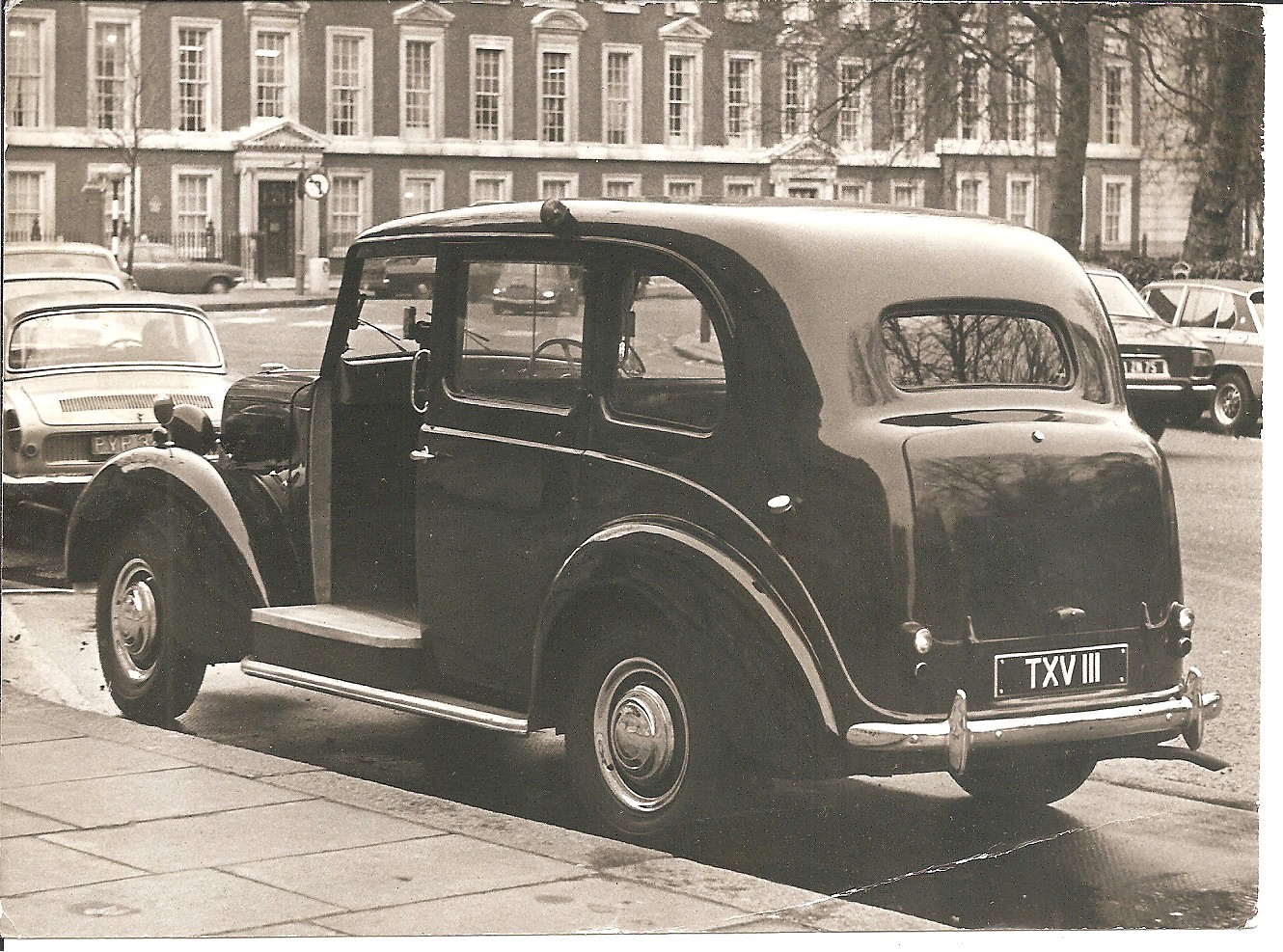
- The same Austin FX3 London taxi as in the photo above while it was still in London, 1973 or later.
Saint Fiacre
 - Papier-mache art courtesy of Kate Hodgson Saint Fiacre is the patron of gardeners and taxicab drivers.
- Papier-mache art courtesy of Kate Hodgson Saint Fiacre is the patron of gardeners and taxicab drivers.
St. Fiacre is memorialized each year on August 30
United States

James Kane came to a bad end after robbing a Chicago horse cab in 1908.
Text and historical photos recall The Cab Hold-up Affair by Norman Beattie.
The American Memory site of the US Library of Congress has many historic taxi photos. Norm Beattie suggests using "taxi cab taxicab" as the search words, and limiting the search to "Photos and Prints."
The New York City Taxi Driver Oral History Project recorded a series of interviews with drivers. See Not Just A Job: Taxi Driver Insight and Inspiration.

"Staging Area" is one of many colorful paintings by Dmitry Samarov. See the following item.
Hack: Stories From a Chicago Cab by writer, artist and long-time driver Dmitry Samarov was published in 2011 by the University of Chicago Press. The book is based on his blog of the same name. See also a sampling of Dmitry's colorful art.
Lou Carter, the Singing Cab Driver of the 1950s on the blog site of WFMU.
Cab Driver, Drive By Mary's Place performed by The Mills Brothers.
Steamy Raimon has a new 90-page humor book for sale: A Very Steamy Taxi Cartoon Book.

The American Taxi - A Century of Service, published by Iconographics.
Live streaming video from New York City's Taxi Talk program 10:30 pm on Friday nights; click on MNN's Channel 67.
Marc Zirogiannis has prepared a comprehensive manual for beginning taxi and limo drivers, The New York State Taxicab Driver's Companion

Title page logo from the 1930 book Hacking New York by Robert Hazard.
Right click the image to download the 45 MB full-length novel.
NY City Cab is a resource for yellow medallion cab drivers and operators, including advertised vehicles for sale and driver positions available.

NYC taxi drivers Noah Forman and Max Cohen demonstrate in a pair of videos
how to catch 100+ green lights in a row safely and without speeding.
A wealth of taxi research by Bruce Schaller is available at Schaller Consulting of New York, NY.
Master Cabbie school of New York City describes itself as the largest taxi driver training center in the world.

Organizer and college professor Biju Mathew's book "Taxi! Cabs and Capitalism in New York City" covers the history of the taxi industry in NYC, and the growth and successes of the NY Taxi Workers' Alliance. Published in 2005, the book is available from Amazon for about $16.
See also the Social Justice Movements Wiki about the NYTWA.

"No Guns, No Knives, No Personal Checks - The Tales of a San Francisco Cab Driver" by Larry Sager, garnered the 2007 Benjamin Franklin Award for the Best First Book (Fiction) from the Independent Publishers Marketing Association earlier this year.
Edward Dalton of Providence, Rhode Island offers heart-felt views from behind the wheel in his book "Real Cab Rides;" published by Isis of Providence in 2004.

Joe Biondo's Real Seattle Taxi blog highlights his role as driver representative on two Seattle-area taxi advisory panels.

Philadelphia driver and activist Steve Chervenka
wrote Memoir of an Independent Contractor.
It is available as an ebook from Smashwords.
D.C. Taxi Heist is a video on YouTube that is critical of a proposed medallion plan in Washington D.C.
Trailer for the taxi movie by Jim Jarmusch, Night on Earth. Belle Peppa offers this review: The story follows five taxi drivers in their cities, LA, NYC, Rome, Paris, and Helsinki. The movie also takes place (you can imagine the world time clocks) simultaneously. The sun is going down in LA and coming up in Helsinki. Each vignette gives us a little view of the city, and a wonderful story of the transient connection between the driver and passenger. The movie is subtitled when the language spoken is not English.

The Ultimate Taxi, Aspen Colorado
The Alliance, Las Vegas driver coalition of labor organizations
Las Vegas taxi Driver offers news, information and tips for Las Vegas taxi drivers and the riding public.
"Customers Like You Make Me Want To Go Back To Being A Hooker: The Life and Times of a Corrupt Las Vegas Taxi Cab Driver," book by Patty Noland available at www.authorhouse.com

Joni Hansen's Taxi Cab Page
Joni Hansen's Taxi Cards
Unusual taxicabs on location, photos from Joni Hansen
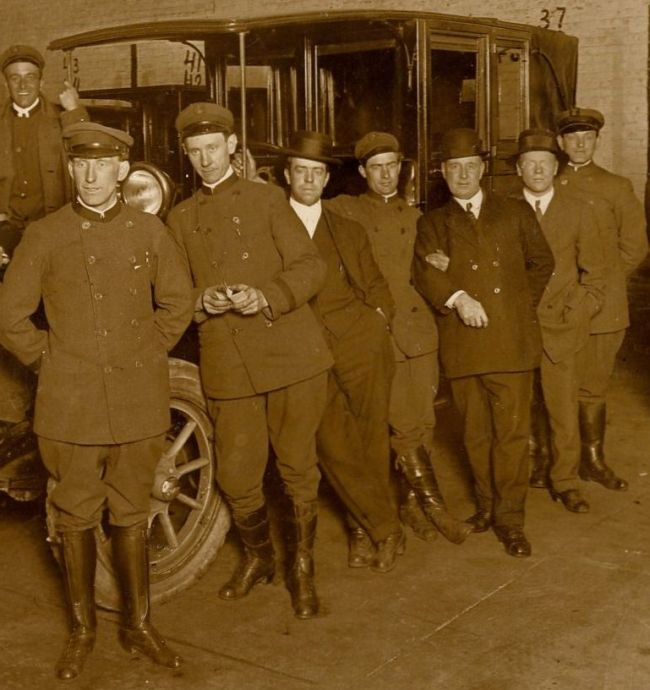
July 2003 taxi boycott at the San Francisco Hilton, a photo essay by Charles Rathbone
San Francisco Taxicab Workers Alliance (AFL-CIO) advocates on behalf of drivers in San Francisco. United Taxicab Workers merged with SFTWA.
The headline asks: Ever See So Many Taxis All At One Time? Read about Nathan Willensky's collection of 10,000 pieces of taxi memorabila including 1,500 toy taxis. The article appeared in the New York Times, 1992.

Toy taxicabs from the collection of Cliff Lundberg
The Spy In the Cab: The Use and Abuse of Taxicab Cameras in San Francisco by Donald Anderson (2012) examines taxi security cameras from a sociological perspective.
Abstract: "Since security cameras were first required in San Francisco taxicabs in 2003, their unfolding story has come to contain many elements familiar to Surveillance Studies: the initial introduction of new technology in the wake of a moral panic; a failure of maintenance and a lapse into unreliability; and finally a resurgence accompanied by surveillance creep. This trajectory is explored using the concept of “surveillance slack,” and the stages of slackening and tensing of taxicab camera surveillance will be considered in terms of how these have been shaped by issues of acceptability (where the line between use and abuse is drawn), of effectiveness (what the cameras are perceived to be doing), and, underlying both of these, of integration, that is, how surveillance interacts with existing lines of tension and conflict in the taxi industry."

1950s poster calling for non-discrimination in the hiring of San Francisco taxicab drivers. The NNLC was founded in Detroit in 1951. It was disbanded in 1956 under pressure from the federal government. Poster by Frank Rowe. See also Docs Populi.
Taxis and San Francisco Labor History: The First 100 Years. Charles Rathbone reviews the ebb and flow of organized labor's ability to influence working conditions among taxicab drivers during the 20th Century; includes historical photographs courtesy of the San Francisco Public Library.

Mrs. Gilbert Gomez and Mrs. Carol Collins Yellow Cab Company drivers, 1958. Photo courtesy of San Francisco Public Library

Illustrator Bill Russell featured Susan Oak on the "Taxi Driver of the Month" page of TODO magazine, which is distributed in taxicabs. See more driver illustrations at Profile Reportage. Illustration copyright by Bill Russell 2007.
A look at the 2003 TX2 London Taxi in service in San Francisco
London Cabs in San Francisco, what's it is like to drive one of the classic London taxis in an American city by Charles Rathbone.

American and London cabs side by side at the Luxor Cab lot in San Francisco.

Diamond Cab of Long Beach, California 1947. Courtesy of Mark Helfrich. See also a 12 MB higher resolution copy of the photo and a 1947 ad from the Long Beach Independent.

Chauffeur's badge, 1924 California.
Courtesy of Bruce Carlton. See also TaxiBadges.com.
Australia, NZ, Asia and Africa
The world's longest taxi ride was arguably Charlie Heard's trip that commenced in Geelong (Victoria) Australia in 1930. Read about his grandson's re-enactment of the epic journey across the continent and back. See also a video on YouTube.
Australian Taxi Drivers Association represents drivers and their organizations.
New Zealand Taxi Federation with links to member companies
How New Zealand Handles Taxi Driver Access Denial
New South Wales Taxi Council, peak body for the NSW Taxi Industry
Victoria Transport Policy Institute, an independent research organization dedicated to developing innovative and practical solutions to transportation problems, located in Victoria, British Columbia. Tries to identify the full benefits, costs and equity impacts of alternative transportation policies and programs.
Taxi Service Improvements, by the Victoria Transport Policy Institute, Australia
Victorian Taxi Association, Australia
New South Wales Ministry of Transport

Taxi chic collection on Pinterest

Fat and happy Buddha image adorns the dashboard of a Bangkok taxicab. By permission of copyright holder Dale Konstanz, author of Still Life in Moving Vehicles
Still Life in Moving Vehicles by Dale Konstanz includes a delightful collection of photos that focus on the superstitious and religious objects inside Bangkok taxis. Dale's book entitled Thai Taxi Talismans is published by River Books.

Iranian director Jafar Panahi's film Taxi won the 2015 Golden Bear prize for best film at the 65th Berlin International Film Festival.
Photos of Tokyo Roof Top Taxi Lanterns. See also Tokyo’s Vibrant, Adorable Taxi Signs Are Disappearing, Japan
PILTOP discussion group for Manila association of drivers and company managers, The Pinag-Isang Lakas ng Taksi Drayber at Operator ng Pilipinas.

A wheelchair accessible bicycle rickshaw in India. Appropriate technology provides work for this driver and transportation for his passenger. Access Exchange International works on transportation access issues worldwide.
Democracy Now hosts a trailer for the film Taxi To The Dark Side which is about abuses in the war on terror. The taxi in the title refers to the killing in custody of a taxi driver named Dilawar in Afghanistan. The film won the 2007 Academy Award for Documentary Feature.

Khaled Al Khamissi's "Taxi, Tales of Rides" about Cairo taxi drivers is reviewed in African Writing Online and in Complete Review.
Organising in the taxi industry: The South African experience, 2003 publication of the International Labour Organization, Geneva. (2.1 MB)
Organizing in the Informal Economy: A Case Study of the Minibus Taxi Industry in South Africa by Jane Barrett for the International Labour Organization, Geneva 2003.

- Photo courtesy of Wikipedia
A Cameroonian bush taxi. Toyota minibus-taxis are the primary mode of public transport in large areas of Africa.
Variety
The Last Cowboy: An Analysis of the Culture of a Taxi Driver by Kimberly Berry
She's No Lady: The Experience and Expression of Gender among Women Taxi Drivers, by Kimberly Berry, April 1997
The Cab Ride, the Internet's most repeated cab driver tale, author unknown.
National Academy of Sciences, Transportation Research Board
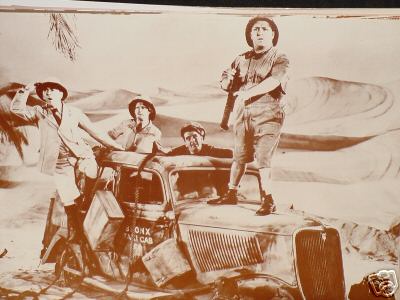
The Three Stooges take a 1940s Bronx taxicab on a trip out west.
Service Excellence, by Terry Smythe, Manitoba Taxicab Board, September 1990
Taking Service Seriously by Terry Smythe
Taxicab numbers are a curiosity in mathematics, a function of cubes. Unfortunately, the series grows to large numbers so rapidly that only two "taxicab numbers" (2 and 1729) could possibly be the numbers on real-world cabs.
Myths, Mysteries and Truths, a collection of short essays about the taxicab industry, by Terry Smythe over some 14 years.

First day issue of a commemorative postage stamp issued by the United States Postal Service, 2002
Portraits of Hope Garden in Transit, taxicabs beautifully decorated as therapy
Taxi Driver Professionalism, by Gord Barton
Me! - A Taxi Driver, Something to be Proud Of!, by Gord Barton
Taxi Driver Ten Commandments, by Gord Barton
Taxi publications
TLC Magazine, New York City trade publication.
Chicago Dispatcher, online version of hard copy monthly newsletter for Chicago area drivers.
96.5 Inner FM Taxi Show, hosted by Melbourne driver David Gawthorn
Call Sign, in-house journal of Dial-A-Cab, London, UK
TaxiNews online edition of Toronto Taxi News, edited by John Duffy

Taxicabs and taxi drivers are a frequent theme in popular culture
The The Transportation Alliance, formerly the Taxicab, Limousine and Paratransit Association has multiple taxi publications.
Taxi-List, international email discussion group for industry participants, successor to the original TAXI-L email list

Yellow Cab driver's hat


